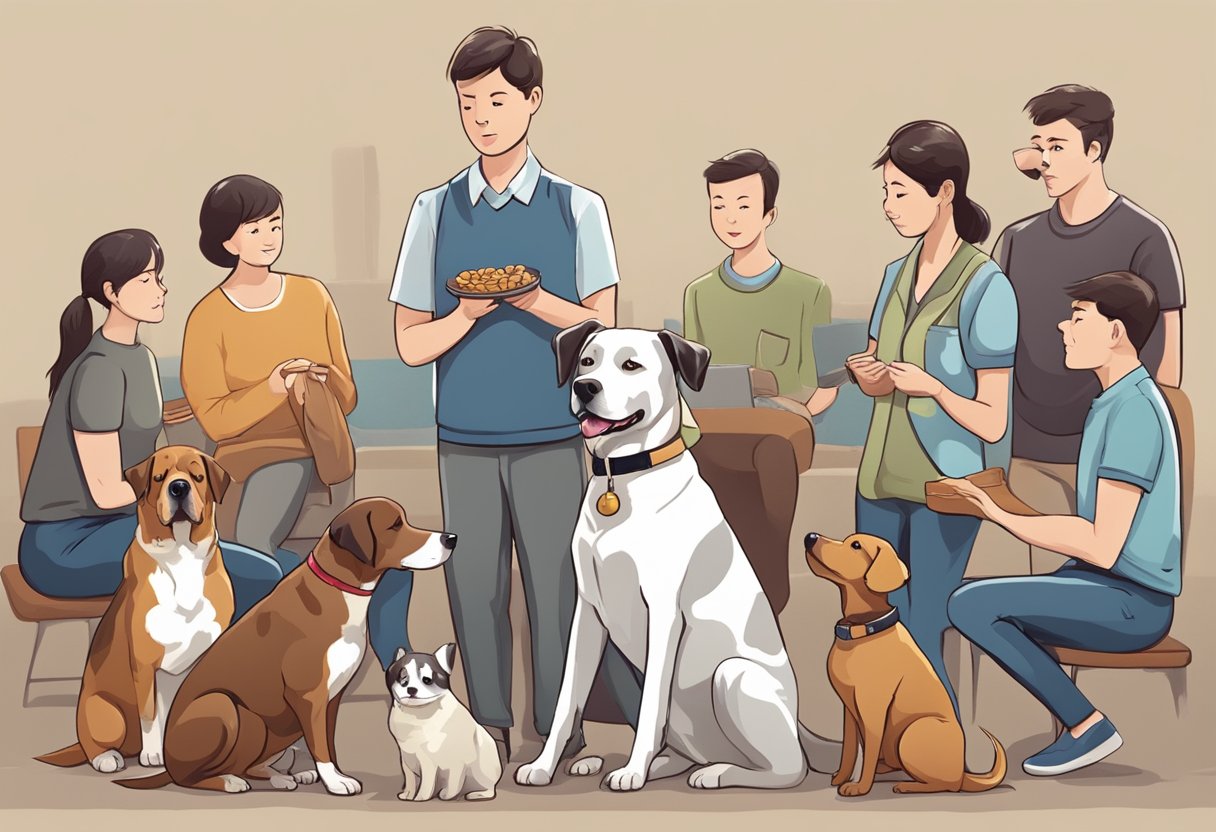Many dog owners seek effective methods to train their pets, regardless of breed. Understanding the unique behavioral traits of different breeds can greatly enhance the training experience. An expert dog trainer shares five reliable tricks that can be applied to every dog, ensuring consistent and positive results.
This article explores these techniques, offering practical insights that can be utilized by anyone, from novice to experienced trainers. Insights from a professional can provide clarity and structure to the training process. By implementing these tricks, owners can foster better communication and stronger bonds with their dogs.
1) “Sit and Stay” training using treats

To train a dog to “Sit” and “Stay,” treats serve as an effective motivator. This method encourages positive behavior and reinforces commands.
Begin by holding a treat above the dog’s nose. Slowly move the treat back over its head. As the dog follows the treat, its natural inclination will be to lower its rear to the ground, achieving the “Sit” position.
Once the dog sits, immediately reward it with the treat and praise. Consistent reinforcement helps the dog associate the command with the desired action.
For the “Stay” command, instruct the dog to sit first. Then, take a step back while giving the command “Stay.” If the dog remains in position, return and reward it with a treat.
Practice short distances initially. Gradually increase the distance and duration as the dog becomes more reliable.
Using treats for training provides clear incentives for dogs to learn. This approach fosters a trusting relationship between the trainer and the dog.
2) Clicker training for behavior reinforcement

Clicker training is a popular method used to reinforce desired behaviors in dogs. It involves using a handheld device that makes a clicking sound when the dog performs a desired action.
The sound of the click serves as a marker, signaling to the dog that they have done something right. This helps create a clear connection between the behavior and the reward.
After the click, a treat or praise follows. This reinforces the behavior, encouraging the dog to repeat it in the future.
Consistency is key in clicker training. The dog must hear the click at the exact moment they perform the correct behavior for it to be effective.
This training method is beneficial for all breeds, as it relies on positive reinforcement rather than punishment. It fosters a strong bond between the dog and the trainer, making learning a positive experience.
3) Using a consistent walking schedule

Establishing a consistent walking schedule is key for a dog’s behavior and well-being. Regular walks help dogs understand daily routines, making them feel secure and settled.
Timing is important. Dogs thrive on predictability. By taking them out at the same times each day, they anticipate walks and adapt more easily to the schedule.
Consistency helps with training as well. A dog that knows when to expect exercise is more likely to be calm and focused during training sessions. This leads to more effective learning and response to commands.
Moreover, regular walks provide both physical and mental stimulation. Dogs need exercise to maintain health and happiness. A fixed schedule ensures that this need is consistently met.
Owners should pay attention to their dog’s specific needs. Factors such as age, breed, and energy level can influence the ideal walking frequency and duration. By adjusting the schedule to meet these needs, owners can help their dogs thrive.
4) Positive reinforcement with praise

Positive reinforcement using praise is an effective technique in dog training. It builds a dog’s confidence and strengthens the bond between the dog and trainer.
When a dog performs a desired behavior, immediate praise encourages repetition. The trainer can use a cheerful voice or specific phrases consistently to create association.
This method works across all breeds. Dogs thrive on attention and approval from their owners. Praise can be verbal, or it can be a gentle touch or scratch behind the ears.
It’s important to ensure the praise is enthusiastic but not overwhelming. Some dogs may respond better to calmer tones. Therefore, understanding each dog’s unique personality is essential for successful reinforcement.
Consistency is key. Trainers should reward positive behavior every time, at least initially. This helps the dog learn what is expected and reinforces good habits effectively.
5) Crate training for effective housebreaking

Crate training is a practical approach to housebreaking dogs. It relies on a dog’s natural instinct to avoid soiling their sleeping area. A crate serves as a safe space for the dog and helps establish a routine.
When introducing a crate, the trainer should ensure it is the right size. The dog should feel comfortable inside, with enough room to stand, turn around, and lie down. A crate that is too large may encourage a dog to use one corner as a bathroom.
Consistency is key in crate training. Dogs should be taken out regularly, especially after meals, playtime, and naps. This reinforces the habit of going to the bathroom outside.
Gradually increasing the time spent in the crate can help the dog become accustomed to it. Initially, short durations are best before extending the time as the dog adapts.
Positive reinforcement is essential during this process. Treats and praise for good behavior will motivate the dog to utilize their crate correctly, making housebreaking more effective.
Understanding Dog Behavior

A solid grasp of dog behavior is essential for effective training. Recognizing the science behind behavior and the importance of consistency aids trainers in achieving desired results.
The Science Behind Training
Dog behavior is shaped by instinct and learned experiences. Understanding these factors can lead to more effective training methods. Dogs communicate through body language, vocalizations, and facial expressions, which reveal their feelings.
Trainers should observe how a dog reacts to various stimuli to tailor their approach. For instance, a wagging tail often signals excitement, while cowering indicates fear. Using positive reinforcement encourages desired behaviors by rewarding them, while negative reinforcement discourages unwanted actions.
Behaviorists emphasize the impact of genetics on temperament. Different breeds may exhibit specific traits, affecting how they respond to training. Knowledge of these traits helps in customizing training strategies for effectiveness.
Why Consistency Matters
Consistency plays a crucial role in dog training. Dogs thrive on routine, and consistent commands ensure they understand expectations. When trainers use the same cues for specific behaviors, dogs learn faster.
For example, if a trainer says “sit” consistently when the dog sits, the command becomes associated with that action. Mixed signals can confuse dogs, leading to frustration for both the dog and trainer.
Additionally, consistent timing in rewards enhances learning. Giving treats or praise immediately after the desired behavior reinforces the connection between action and reward.
Lastly, consistency extends beyond commands to interactions. Training sessions should have a similar tone and environment, allowing dogs to feel secure and focused. This predictability fosters a better learning experience.
Effective Communication with Dogs

Effective communication with dogs involves understanding their body language and using vocal cues. Both elements are crucial in establishing a strong bond between the trainer and the dog, leading to better behavior and obedience.
Using Body Language
Dogs are highly attuned to human body language. They often pick up on subtle cues, such as posture, movement, and facial expressions.
- Posture: Standing tall with a relaxed demeanor conveys confidence. Conversely, leaning over a dog may be perceived as threatening.
- Hand Signals: Simple gestures, like raising a hand or pointing, can be used effectively. Consistency in these signals helps dogs recognize commands.
- Facial Expressions: A cheerful smile can promote positive interaction, while a frown may make a dog feel anxious.
Understanding how dogs interpret these cues allows for clearer communication and enhances training outcomes.
The Role of Vocal Cues
Vocal cues are essential for directing a dog’s attention and reinforcing commands. The tone and volume used when speaking can heavily influence a dog’s response.
- Consistency: Using the same words for commands helps dogs learn and understand expectations. For example, saying “sit” every time can reinforce the action.
- Tone of Voice: A high-pitched, cheerful tone can encourage a dog to engage and play, while a low, firm tone signals authority.
- Volume Control: Calm, moderate volume is best for everyday commands, whereas a louder voice may be needed for urgent situations.
By paying attention to both body language and vocal cues, trainers can create a more effective communication strategy with dogs.



